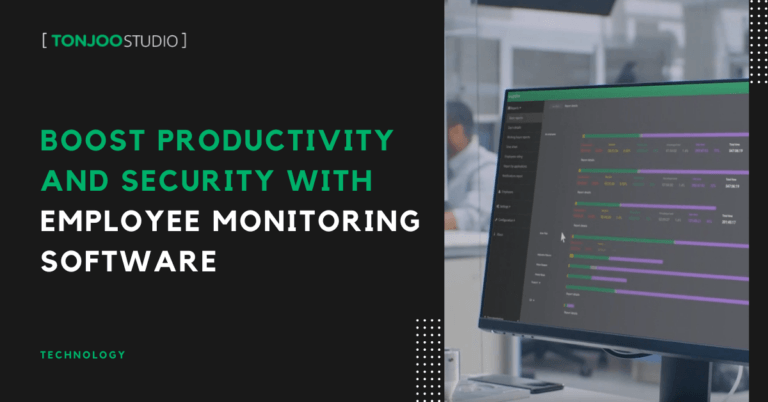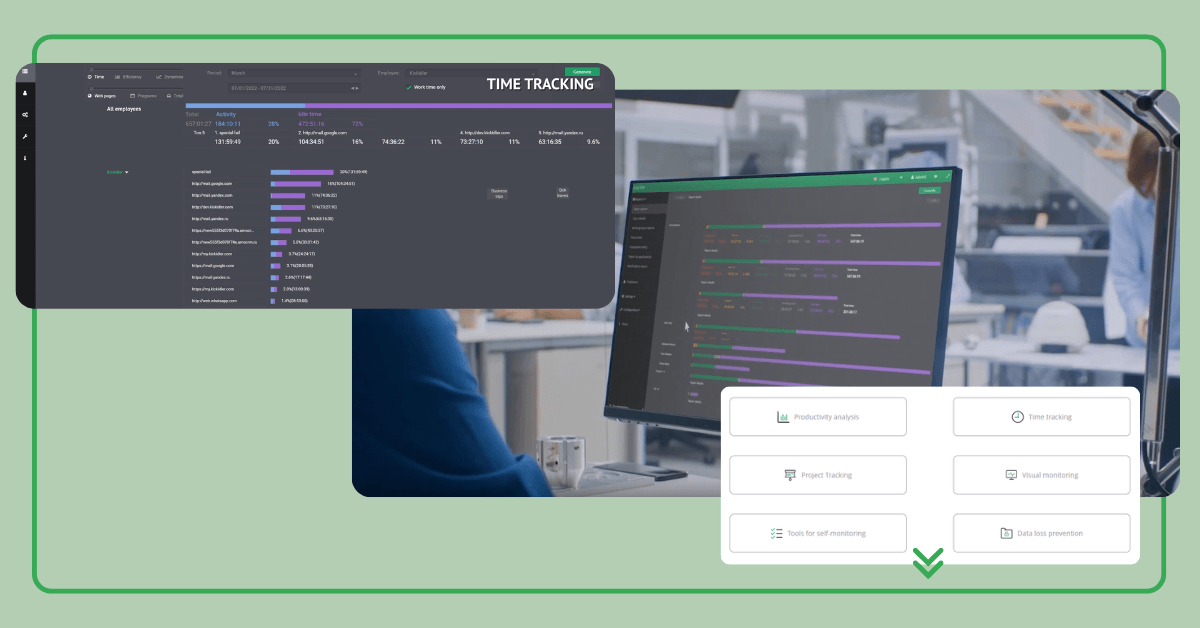Employee Monitoring Software: What Employers Should Know

Advertisements
As remote work becomes increasingly prevalent, maintaining employee productivity has become a challenge. This is where employee monitoring software can be a cutting-edge solution.
The COVID-19 pandemic accelerated a shift from traditional office settings to remote work. For instance, the U.S. Bureau of Labor Statistics reported that one out of five employees work remotely.
However, this transition has brought forth new challenges, such as workers pretending to be online while doing nonwork activities and an increased risk of data breaches.
By implementing software to monitor employees, your business can effectively pivot to either a fully remote or hybrid model without compromising performance and/or profitability.
- What is Employee Monitoring Software?
- The Benefits of Using Employee Monitoring Software
- Key Features to Consider When Choosing Employee Monitoring Software
- Does Employee Monitoring Software Violate Privacy?
- Industries that Use Employee Monitoring Software
- How to Choose the Right Employee Monitoring Software?
- How to Implement Employee Monitoring Software to Your Company
- Conclusion
Advertisements
What is Employee Monitoring Software?
Employee Monitoring Software is an effective tool to help employers oversee their employees’ computers from a centralized location.
This software can monitor specific employees’ actions, track all the apps and websites they accessed, and even identify suspicious activity they did. This monitoring includes but not limited to:
- Recording computer activity
- Opening email
- Checking phone logs and calls
- Checking logs of websites visited
With the ability to detect unproductive behaviour, employers can proactively address issues. Ultimately, employee monitoring software improves productivity, security, and a compliant workplace.
Employee monitoring software has become the norm, with a staggering 78% of employers using it to track remote workers, according to Express VPN data.
The Benefits of Using Employee Monitoring Software
Employee monitoring software can go beyond just monitoring your employees. Here are the benefits of using employee monitoring software, both for employers and employees:
Advertisements
For Employers
- Improve workflow productivity: Employee monitoring software can provide comprehensive reports on time being spent on tasks. Using that data, you can identify which area of the workflows that you can improve and optimize.
- Reduce operational costs: By optimizing workflows, a domino effect occurs, leading to reduced operational costs through the elimination of redundant tasks and unnecessary expenses.
- Help remote working management better: This software can help monitor employee time usage and project progress, and make sure that remote employees keep on track and meet the business goal.
- Enhance security from data breaches: Employee monitoring software also can help protect sensitive data by looking at suspicious employee behaviour. Through early detection, you can mitigate the risks of data loss.
For Employees
- Have fairer performance evaluation: Performance evaluation is a standard practice in most corporations. By using employee monitoring software, you can gather more accurate data on the employees’ productivity and be able to provide a fairer, data-driven performance evaluation.
- Improve accountability: Knowing that their activities are being monitored can lead them to be more accountable for their work. As a result, they can have a better focus on their tasks.
- Enhance work-life balance: By being able to maintain focus on their task, the employee can get their tasks done efficiently, preventing work from spilling over into personal time. This contributes to a better work-life balance.
Advertisements
Key Features to Consider When Choosing Employee Monitoring Software
Choosing the right employee monitoring software should also consider the features it has to offer. The most needed features that are commonly demanded by employers are as follows:
- Time Tracking: This feature enables you to record the amount of time your employees spend on specific tasks or projects.
- Screen Monitoring: This feature helps you to capture screenshots or screen recordings of your employees’ activities.
- Activity logging: This feature tracks employee interactions with computer systems, such as applications, websites, and files that they accessed.
- Reporting: This is a feature where all data that have been recorded are presented in the form of a dashboard that you can easily get insight into.
- Data loss prevention (DLP): This feature protects sensitive company data from access that has no authorization or loss.
- Project tracking: This feature helps you to monitor projects of your company, but focuses on the specific projects that you want.
- Remote access: This feature allows managers/employers to take over employee’s computers when there is an emergency situation.
These core features empower businesses to optimize workflows, enhance security, and make informed decisions. While these features represent the current state of employee monitoring software, technological advancements are continually expanding capabilities. Future developments may include:
- AI-powered analytics: Deriving deeper insights from employee data.
- Enhanced privacy features: Balancing monitoring needs with employee rights.
- Integration with other business tools: Seamlessly connecting with HR, project management, and communication platforms.
By staying informed about the latest trends, businesses can leverage employee monitoring software to its full potential, driving productivity and efficiency while safeguarding sensitive information.
Advertisements
Does Employee Monitoring Software Violate Privacy?
Many employees are concerned about employee monitoring software violating their privacy. It has been quite a prominent issue since this software has taken monitoring to the next level.
From a legal perspective, the implementation of employee monitoring software depends on where the company is operating. For example, in the US employers have the right to monitor their employees’ work computer usage.
On the other flip of the coin, employers in Europe have different legal policies. They need to have employee’s concerns before implementing the monitoring activities on their computer.
Ethically speaking, the argument that employers pay their employees to do their jobs is quite valid that employers have the right to oversee whether they are working or not. They need to make sure that the job gets done.
However, to make sure that it covers all the aspects of price and addresses the legal and ethical concerns, employers should consider the following aspects:
- Scope and limitations: Monitoring should be restricted to activities directly related to job responsibilities and company resources.
- Data protection/security: Only collect data necessary for achieving the monitoring objectives.
- Consent: Explain the purpose, scope, and data handling practices.
- Transparency: Maintain an open dialogue with employees about monitoring practices.
By following to those principles, employers can mitigate privacy concerns and build trust with employees. It is essential to strike a balance between monitoring needs and employee rights to ensure a productive and respectful work model.
Advertisements
Industries that Use Employee Monitoring Software
Baca Juga
Employee monitoring software has been adopted by many industries, especially ones with remote or hybrid working environments. These are the common industries which use software to monitor their employees:
- IT and software development industries: This type of company often uses employee monitoring software as many employees work remotely and they need to maintain projects accordingly and protect the data securely.
- Customer support industries: Monitoring can be used to assess call handling times, customer satisfaction, and agent productivity.
- Finance and accounting: These industries often handle sensitive data, making employee monitoring a crucial component of risk management.
Beyond these core industries, legal firms, government agencies, and healthcare providers also commonly adopt employee monitoring solutions to meet specific operational and compliance requirements.
How to Choose the Right Employee Monitoring Software?
Choosing the right employee monitoring software can be challenging since there are many options out there. To make the right decision, you should consider these aspects:
1. Business Needs
Before utilizing one, you need to identify your business needs. You can start by understanding the type of industry and the size of your company since it will lead to certain requirements.
Different work models of your business also is an important consideration, whether it is a fully remote or hybrid. You also need to define your goal clearly, is it for productivity tracking, time management, or security?
2. User-friendliness
After you understand your business needs, you can begin to sort out some software that is used for monitoring employees. In this phase, you can look at its user-friendliness. Other than because it will be more easily adopted, it also indicates that the software is well-developed.
3. Vendor Reputation
A vendor’s reputation is crucial when selecting employee monitoring software. A reputable vendor is more likely to provide reliable, secure, and effective solutions.
To judge a good vendor reputation, you can examine some variables like customer reviews and testimonials, industry recognition, and customer support.
4. Pricing Option
Understanding the pricing structure of employee monitoring software is crucial for budget planning. By carefully analyzing pricing options and considering the overall value of the software, you can make an informed decision that aligns with your budget and business needs.
How to Implement Employee Monitoring Software to Your Company
Implementing employee monitoring software requires careful planning and execution to ensure its effectiveness and acceptance. After you successfully choose the best employee monitoring software, here are some key steps to implement it:
1. Clear Communication with Employees
Open and honest communication is essential when implementing employee monitoring software. Clearly explain the reasons for the software, outlining its benefits such as increased productivity and improved security.
Address privacy concerns directly, assuring employees that their data will be handled securely and confidentially. Building trust is crucial for a successful implementation.
2. Develop a Comprehensive Monitoring Policy
A well-defined monitoring policy is vital for both employees and employers. Clearly outline which activities will be monitored, how data will be used, and how long it will be retained. Ensure the policy aligns with relevant data protection laws and regulations to maintain legal compliance.
3. Gradual Implementation
A phased approach to implementation can help minimize resistance and identify potential issues. Begin with a pilot program to test the software in a limited setting.
Provide comprehensive training to employees to ensure they understand the software’s purpose and functionality. Continuously monitor the software’s performance and make necessary adjustments based on feedback and results.
Conclusion
Employee monitoring software can be a powerful tool for boosting productivity and data protection, especially for companies with remote or hybrid systems. It offers features like time tracking, activity logging, and data loss prevention, all aimed at improving efficiency and security.
Kickidler.com is a reputable Employee Monitoring Software (EMS) provider offering a comprehensive suite of features to meet your needs. Its user-friendly interface and advanced technology make the implementation towards your business hassle-free and efficient.
Consider exploring Kickidler.com to see how employee monitoring software can benefit your company.
Last Updated on August 15, 2024 by Tonjoostudio Team
Advertisements






